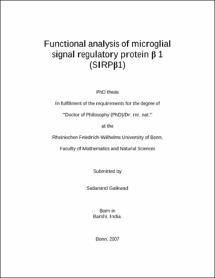Functional analysis of microglial signal regulatory protein β 1 (SIRPβ1)

Functional analysis of microglial signal regulatory protein β 1 (SIRPβ1)

| dc.contributor.advisor | Neumann, Harald | |
| dc.contributor.author | Gaikwad, Sadanand | |
| dc.date.accessioned | 2020-04-10T20:08:49Z | |
| dc.date.available | 2020-04-10T20:08:49Z | |
| dc.date.issued | 2007 | |
| dc.identifier.uri | https://hdl.handle.net/20.500.11811/3186 | |
| dc.description.abstract | Microglial cells are the resident macrophages of the central nervous system (CNS) and thus form the interface between the neural parenchyma and the immune system. Although little is known about microglia in the CNS, it is obvious that they are quickly activated in all acute pathological events that might affect the CNS. In this study, the role of signal regulatory protein-β1 (SIRPβ1) was investigated by analyzing the effect of SIRPβ1 engagement on phagocytosis, inflammatory responses as well as on intracellular signalling in microglia. The signal regulatory proteins (SIRPs) are a family of transmembrane glycoproteins that are mainly involved in signal transduction cascade and belong to the immunoglobulin (Ig) superfamily. These proteins are expressed in the hematopoietic cells including granulocytes, monocytes, dendritic cells, lymphocytes and in the cells of the CNS. Although the extracellular domains of SIRPs are highly similar, classical motifs in the cytoplasmic or transmembrane domains distinguish them as either activating (β) or inhibitory (α) isoforms. The activating isoform SIRPβ1 have a short cytoplasmic tail which was reported to physically associate with the immunoreceptor tyrosine-based activation motif (ITAM) containing adaptor protein DAP12. We demonstrated that SIRPβ1 associates with DAP12 activating molecule and is expressed in microglia. Expression of SIRPβ1 and DAP12 were found to be in macrophage, myilod cells and splenocytes but do not found in neurons. Protein expression of SIRPβ1 and DAP12 in microglial cells was analyzed in brain, spinal cord and spleen from 7-8 week old EAE induced mice (mouse model of multiple sclerosis) and from 12 months old APP transgenic mice (mouse model of Alzheimer’s disease) by immunohistochemistry with purified antibodies directed against SIRPβ1. Gene transcript levels of SIRPβ1 and DAP12 significantly increased in the spinal cord of mice upon EAE induction as well as in the brain of APP transgenic mice. Double labelling with antibodies directed against SIRPβ1 and microglia marker Iba1 confirmed the microglial morphology of the cells, which were positively stained for SIRPβ1. We showed that dying neurons, splenocytes as well as β-amyloid and myelin are phagocytosed by microglia and stimulation of SIRPβ1 promotes phagocytosis in microglia by inducing the tyrosine phosphorylation of DAP12. To study the pathophysiological function of SIRPβ1, we used a lentiviral strategy to either knock down SIRPβ1 by RNA interference or to overexpress SIRPβ1. Our results demonstrate that the deficiency of SIRPβ1 results in diminished microglial uptake of apoptotic neurons, splenocytes, Aβ-peptide and myelin which gives additional significant functional input of microglial SIRPβ1 and its associated signalling molecule DAP12 in phagocytosis. This made us to conclude that microglial SIRPβ1 plays an important role in removal of apoptotic cells, suggesting that SIRPβ1 mediated phagocytosis could be a mechanism involved in ongoing response to neurodegeneration. Thus, understanding the role of SIRPβ1 mediated phagocytosis in the neurodegenerative process may help to elucidate the difference between normal microglial homeostasis and the disease state, offering hope for the generation of novel therapeutic compounds. | |
| dc.language.iso | eng | |
| dc.rights | In Copyright | |
| dc.rights.uri | http://rightsstatements.org/vocab/InC/1.0/ | |
| dc.subject | SIRPb1 | |
| dc.subject | DAP12 | |
| dc.subject | microglia | |
| dc.subject.ddc | 570 Biowissenschaften, Biologie | |
| dc.title | Functional analysis of microglial signal regulatory protein β 1 (SIRPβ1) | |
| dc.type | Dissertation oder Habilitation | |
| dc.publisher.name | Universitäts- und Landesbibliothek Bonn | |
| dc.publisher.location | Bonn | |
| dc.rights.accessRights | openAccess | |
| dc.identifier.urn | https://nbn-resolving.org/urn:nbn:de:hbz:5N-12675 | |
| ulbbn.pubtype | Erstveröffentlichung | |
| ulbbnediss.affiliation.name | Rheinische Friedrich-Wilhelms-Universität Bonn | |
| ulbbnediss.affiliation.location | Bonn | |
| ulbbnediss.thesis.level | Dissertation | |
| ulbbnediss.dissID | 1267 | |
| ulbbnediss.date.accepted | 05.11.2007 | |
| ulbbnediss.fakultaet | Mathematisch-Naturwissenschaftliche Fakultät | |
| dc.contributor.coReferee | Kolanus, Waldemar |
Files in this item
This item appears in the following Collection(s)
-
E-Dissertationen (4104)




